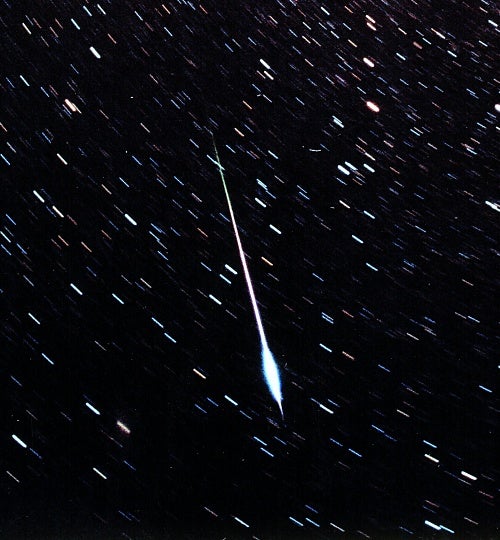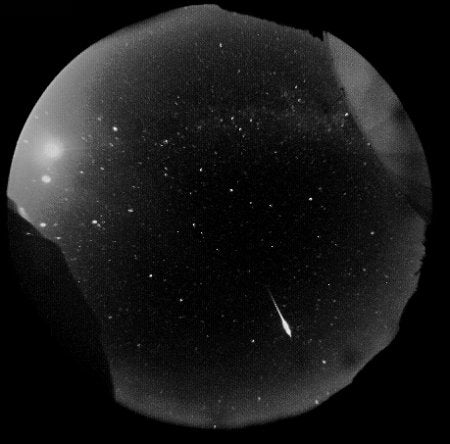Summer is notable for two spectacular events: July 4th, with its fireworks displays, and the annual Perseid meteor shower — celestial fireworks — in mid-August.
Some of this material enters Earth’s upper atmosphere, screaming in at a speed of 133,000 mph (214,000 km/h). These icy particles don’t last long at such speeds, burning up almost instantly some 60 miles (97 km) up in brilliant, glowing streaks we call Perseid meteors. None are robust enough to reach the ground, which permits skywatchers to enjoy the show without fear of being clobbered by a Perseid.
One cannot, however, say the same for spacecraft, which are not shielded by the protective blanket of Earth’s atmosphere. In fact, there is one satellite that experts think was “taken out” out by a Perseid.
Back in August 1993, the Perseids were expected to be anything but normal; Comet Swift-Tuttle had passed Earth’s orbit in 1992, and astronomers predicted an unusually intense shower. Spacecraft operators took steps to protect their vehicles. The Hubble Space Telescope was pointed opposite the constellation Perseus (the direction the meteors appear to come from). Solar arrays of commercial and defense satellites were oriented so they were “edge-on” to the meteor stream. Launch of the space shuttle Endeavour was postponed until after the shower’s predicted maximum.
At its 1993 peak, rates for the Perseid meteor shower reached about 350 meteors per hour, or more than 3 times normal. One of those dust-size pieces of comet fluff struck OLYMPUS’ jammed array.
You might imagine the meteor would put a hole in the solar panel and leave the rest of the satellite undamaged, and it is, indeed, true the meteor probably left a crater of some sort on the array surface. But, another effect, one engineers had not previously considered, caused the spacecraft’s demise.
Spacecraft solar arrays generate electricity when exposed to sunlight, and so they have an electrical charge. The meteoroid vaporized when it struck the array, generating a small cloud of electrically charged gas. This plasma acted like a wire, allowing electrical charge on the array to move into the spacecraft’s attitude control electronics.
OLYMPUS tumbled wildly. By the time operators regained control, the satellite’s attitude-control fuel was exhausted, and its useful life was over. By month’s end, the satellite was moved to a “graveyard orbit” and shut down. OLYMPUS had been “killed” by a Perseid.
Much to the relief of satellite operators, this year’s Perseids will not outburst like in 1993. Although an increased activity was predicted earlier this year (and is reported in Astronomy‘s August issue), more detailed calculations no longer show this component. Rates will be normal, peaking at about 100 meteors per hour around 11:54 P.M. EDT on the night of August 11. This is just after the setting of the First Quarter Moon, so the best part of the shower will occur in a darkened sky.
Observers in England and western Europe are best placed for the maximum, as Perseus will be high in the pre-dawn sky. However, the shower will not disappoint skywatchers on the other side of the Atlantic, where observers may see as many as 80 meteors per hour between 4 and 6 A.M. Go out after moonset, lie down on a comfortable lawn chair, sleeping bag, or blanket, and enjoy nature’s fireworks.
And be grateful for the atmosphere’s protection. Satellites — and future lunar explorers — will have to make do without it.











